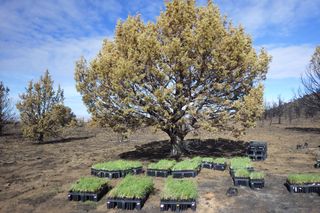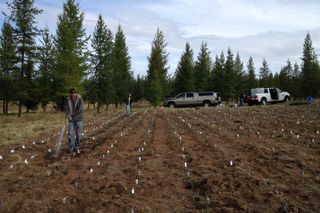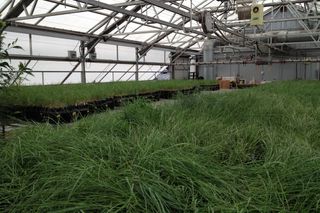
To Prevent Another Dust Bowl, the US Must Sow the Right Seeds

Diane Banegas currently works in the area of science delivery for the research arm of the U.S. Forest Service. She has also worked for the National Science Foundation, the Office of Naval Research, and Los Alamos National Laboratory. Banegas contributed this article to Live Science's Expert Voices: Op-Ed & Insights.
In the 1930s, a serious drought, combined with excessively intensive farming practices, transformed the U.S. Great Plains into a dust bowl, wreaking economic devastation on farmers and their communities. The fertile topsoil that fed a nation was, quite literally, blowing in the wind.
The U.S. government was desperate for something — anything — that would anchor the remaining topsoil back to the ground.
New seeds, new breeds
The solution was to plant a new breed of crop, primarily crested wheatgrass from Russia and other closely related species, that could hold the topsoil despite drought conditions.
Because crested wheatgrass thrives in harsh conditions, including drought, and provides good grazing for livestock, the plant seemed like the ideal remedy for over-grazed rangelands in the Great Plains and other parts of the country. But the seeds of this species, once established, create large populations that out-compete other species.
A landscape dominated by a single grass is a monoculture that provides poor habitat and foraging for wildlife and limits resources for pollinators.
Sign up for the Live Science daily newsletter now
Get the world’s most fascinating discoveries delivered straight to your inbox.
"Healthy ecosystems need diverse plant communities of grasses, forbs [herbaceous flowering plants other than grasses] and shrubs that are native species with traits adapted to the right climates, so they can establish successfully," said Francis Kilkenny, who leads the Great Basin Native Plant Project, a joint effort of the U.S. Department of Agriculture's Forest Service and the U.S. Department of Interior's Bureau of Land Management (BLM).
The project evaluates seeds in "common garden studies." Native seeds gathered from different areas of the country with different climates are all grown together in a single garden under the same conditions to see which varieties do best. A common garden study for plants is similar to "twin studies" done on humans to separate the effects of nature versus nurture.
The most robust seeds become the foundation for restoration projects to rebuild ecosystems after big wildfires, such as those currently wiping out vast sagebrush expanses in Nevada, Idaho and Utah.

Restoring the land
In the wake of a big fire, the agency responsible for the landscape will make a rapid assessment about what's needed for restoration, then request the seeds necessary to achieve those goals.
If the goals are as simple as preventing erosion and stopping "cheatgrass," a notorious non-native invasive, from dominating the landscape, managers might grab something as cheap and easy to establish as a crested wheatgrass variety. This is especially true if the land is in an arid region with less than 11 inches (28 centimeters) of annual precipitation. On the other hand, the restoration goals may be a biologically diverse plant community that can shelter and nourish wildlife and pollinators, help filter water and air for human communities, and reduce the size and intensity of subsequent wildland fires. In that case, a land manager at the district or forest level will want a mixture of tested native seeds.
In the Great Basin — a region in the Western United States that has no drainage to the ocean and includes most of Nevada and parts of Utah, California, Oregon and Idaho — wildfires have become more frequent and severe . This is in part due to drought and invasive species like cheatgrass. It has created a problem analogous to the Dust Bowl of the 1930s Great Plains , but influenced by the combined forces of drought, wildfire and invasions by non-native species.
"Extended drought in the Great Basin doesn't immediately threaten the U.S. food supply like the Dust Bowl did, but the consequences can be just as severe over time," Kilkenny said. [Another 1930s Dust Bowl Drought Possible This Century (Op-Ed )]
Those consequences include disappearing pollinators, loss of wildlife habitat for key species like the sage grouse, and landscapes that can no longer serve as nature's water-filtration system for the streams and rivers used by agriculture and cities. Also, big wildfires fueled by cheatgrass pollute the air with smoke, and after the fire, erosion results in more and bigger dust storms. If the landscape isn't quickly restored, cheatgrass takes over once again, which leads to another big fire.
"It's a vicious, repetitive cycle," Kilkenny added. "And livestock only eat cheatgrass for about a two-week period when it's green and sprouting. The rest of the time, it's useless as forage" — hence the word "cheat" in the species' common name.
A more "holistic" landscape
To help managers restore landscapes with a holistic, biologically diverse ecosystem that benefits wildlife, agriculture and humans, Kilkenny and his colleagues are breeding native plant varieties, such as bluebunch wheatgrass, that fit well with local and regional climates.
The researchers use common garden trials to assess which varieties will perform best in which locations, but the scientists avoid the agricultural practice of selecting for a single trait over multiple generations.
"We want good seed production so we can market enough seeds for restoration purposes, but the varieties need to remain wild, not domesticated, or they won't be as drought-tolerant and establish as well once planted," Kilkenny said.
Native, wild species typically don't produce seeds at the rate of domesticated plants. However, breeding plants for seed production can come at the expense of other traits, such as drought tolerance, and reduce the plants' ability to establish themselves and thrive in the wild.
"It's a fine line to walk, and one of the reasons why creating an adequate supply of different varieties of native seed mixes for large, landscape-scale restoration projects takes so long," added Kilkenny. Anatone, a variety of bluebunch wheatgrass planted across the West, concerns him, he said, because using only one variety of a single species, even a native plant species, also raises monoculture concerns.
Ultimately, the loss of genetic diversity could reduce how resilient bluebunch populations are to changing climates and drought, and also make gene conservation, necessary for developing future varieties, even more difficult.
"We need to use true regional varieties for successful restorations," said Kilkenny. With that endgame in mind, he has developed guidelines for land managers to select the best seeds available for burned areas they are trying to restore.

The living landscape
A healthy rangeland ecosystem needs to include at least three of the four major plant groups: grasses, forbs, shrubs and trees.
Grass, which holds the soil best in dry environments, is wind-pollinated. Grasses prevent erosion, and their seeds feed rodents, like prairie dogs. Forbs don't hold the soil as well, but their flowers are good for pollinators and insects, and insects are food for birds. Shrubs like sagebrush provide habitat for birds, such as the greater sage grouse, whose range is sagebrush country in the western United States. Trees provide food and habitat for many species.
A BLM manager can easily obtain and plant several seed types to optimize a restoration's success, but not several hundred. The research findings tell managers which seeds have the best chance of succeeding in a given region, at a particular elevation, for a certain time of year, in current climate conditions.
Those findings do not come easily. It has taken decades to develop successful new seed varieties for grasses. First, the seeds must be collected in the wild, a time-consuming and labor-intensive effort. These seeds must be tested in common garden trials to find the hardiest strains, and those strains must be grown for seed production. Then, the seeds must be harvested and put on the market, and land managers must be made aware of them and their qualities so they can plant the right seeds in the right locations at the right times using the right planting techniques.
As a direct result of Kilkenny and his colleagues' work, land managers' restoration goals have shifted from the simplistic aims of planting something quick over large areas to stop erosion and provide forage for livestock, to planting a diverse plant community that also serves humans and wildlife.
The scientists are building on their success in producing native-grass seed mixtures with similar work on forbs, which produce the wildflowers so essential to pollinators. So far, the researchers have increased the number of forbs available, but this work lags behind the scientists' success with grasses.
"No one has perfected the art of sagebrush recovery yet, but we have some ideas" Kilkenny said. "We know restoration of habitat is easier in areas of high precipitation. We also know sagebrush seeds can fail to establish if a seed mixture contains an aggressive grass like crested wheatgrass. And restoring sagebrush or any other type of habitat is much easier if the seeds originated in the same type of climate as the one they are going into."
A century of study
"We've learned an awful lot about what doesn't work," Kilkenny said. "But our knowledge has advanced considerably since the 1930s." He notes five major findings since then:
- Climate is more important than geography when predicting how well seeds will grow and establish themselves. Seeds don't care where their parents lived if the temperature suits them and if they get the right amount of sunshine and precipitation.
- Timing of seed planting makes a big difference. Year to year, even week to week, variation in weather patterns can affect the restoration success of a burned site.
- The method of planting matters. Blowing seeds from a plane may be a fast way to cover a lot of territory, but it's not that effective. The seeds, dropped from large drums attached to the planes, scatter in the wind, sparsely covering the ground below. Their contact with the earth is also less secure than for seeds planted in furrows by a tractor. As a result, many of the seeds fail to establish themselves, and those few individuals that do will not compete as well in nature as will the densely planted seeds. To achieve the best results, scientists recommend tamping seeds into the ground to ensure they have good contact with the soil, or in some cases, planting a species in the form of "plugs."
- Long-term monitoring after planting is critical to determine the effectiveness of different seed mixes and restoration techniques. If a restoration effort fails in the interior West, a likely outcome is that aggressive non-native species like cheatgrass or Medusa head will move in. These species crowd out native species and offer little by way of nutrition to pollinators, wildlife or livestock. Cheatgrass is also a notorious fire hazard.
- Keeping livestock off seeded rangeland for at least three years improves a restoration effort's likelihood of success.
Scientific research is only half the battle. Delivering knowledge about successful seeding of native species to land managers is the other half. Kilkenny and his colleagues report their marketing efforts are slowly making progress due to the growing body of knowledge on seed science; the partnership efforts with other agencies, especially the BLM; and Internet-based resources, like the Land Treatments Digital Library(managed by the U.S. Geological Survey, it catalogs legacy land treatment information on BLM lands in the western United States).

A national approach
"Today, BLM land managers purchase 70 percent native-species seed," Kilkenny said. "It used to be just the opposite. Our early steps to get land managers to start using native rather than non-native species made a huge difference. This shifting policy since the turn of the century resulted in the National Seed Strategy."
This is a partnership involving the U.S. Department of Agriculture, U.S. Department of the Interior and Plant Conservation Alliance, and it guides ecological restoration across major landscapes, especially those lands damaged by rangeland fires, invasive species, severe storms and drought.
"Fires, invasive species and other threats don't respect state, local or other jurisdiction boundaries," Kilkenny said. "Successful restoration after big fires like the Soda Fire southwest of Boise, Idaho, that reached into Oregon is a national effort involving multiple agencies and organizations. Our years of research and working with others is paying off, because, through the efforts of BLM's national seed coordinator and district managers, appropriate sagebrush seed is being used on a large scale in seed mixtures for the Soda Fire."
Success on a national scale will continue to happen through a nationwide network of native seed collectors, a network of farmers and growers working to develop seed, a network of nurseries and seed storage facilities to supply adequate quantities of appropriate seed, and a network of restoration ecologists who know how to put the right seed in the right place at the right time.
The scientific data and experimental designs that drive restoration projects are also improving, Kilkenny noted. There are a lot of steps between a restoration team choosing a seed mix and actually planting the mix in the field. When the focus was primarily on the immediate concerns of preventing erosion and blocking cheatgrass, managers were less concerned about what variety of seed they used. Today's focus on a varied seed mixture that yields greater biodiversity for short- and long-term restoration requires, and has led to, much more accurate record keeping.
Kilkenny's lab is also currently assessing plantings 15 years after restoration, because long-term results from plantings are not well-studied. "Today, the prevalent idea is, if you put a diverse seed mix out there, eventually something will work, but we need to know more about that from a scientific perspective."
All of this research into seeds is necessary for successful restoration of ecosystems damaged by fire and invasions of non-native species in the Great Basin and beyond. The research results will continue to improve land managers' ability to obtain and use native plants for rehabilitation and restoration projects. When it comes to restoration, native species are key to making sure the Great Basin doesn't have a Dust Bowl in its future.
A recently published report offers more information about Forest Service research on the effects of drought of forests and rangelands in the United States: Effects of Drought on Forests and Rangelands in the United States: A Comprehensive Science Synthesis. A collaborative effort authored by 77 scientists from the Forest Service and other federal agencies, research institutions and various universities across the United States, the assessment establishes the science for managing landscapes for resilience and adaptation to drought.
Follow all of the Expert Voices issues and debates — and become part of the discussion — on Facebook, Twitter and Google+. The views expressed are those of the author and do not necessarily reflect the views of the publisher. This version of the article was originally published on Live Science.
Most Popular


